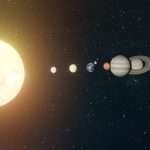Earth’s Axial Tilt & Elliptical Orbit
At the heart of seasonal change is axial tilt, also known as obliquity. Earth’s axis leans at approximately 23.5° from perpendicular to its orbital plane. This tilt means that as Earth circles the Sun, each hemisphere alternately tilts toward (summer) and away (winter) from direct solar rays, shifting both solar intensity and day length.
Meanwhile, Earth’s orbit is slightly elliptical, with an eccentricity of ~0.0167. The distance varies by about 3.3% between perihelion (closest, ~91.4 million miles in early January) and aphelion (farthest, ~94.5 million miles in early July). This distance change modulates received solar energy by roughly 7%, but because perihelion coincides with Northern Hemisphere winter, its effect is overshadowed by tilt.
| Season | Declination | Approx. Earth–Sun Distance (miles) | Solar Angle Impact |
|---|---|---|---|
| Spring Equinox | 0° | ~93 million | Equal day/night globally |
| Summer Solstice | +23.5° | ~94.5 million | Highest sunlight intensity |
| Autumn Equinox | 0° | ~93 million | Equal day/night globally |
| Winter Solstice | -23.5° | ~91.4 million | Lowest sunlight intensity |
The Four Seasons Explained
Spring
Beginning at the March equinox (around March 20), the Sun crosses the equator heading north. In the Northern Hemisphere:
- Insolation: Solar rays move from 0° toward +23.5° declination, warming land masses by up to 10–15°F above winter lows.
- Daylight: Gains of 2–3 minutes per day around temperate latitudes lead to rapid plant growth and snowmelt.
- Biological cues: Migratory birds return; deciduous trees begin budburst.
Summer
At the June solstice (around June 21), the Northern Hemisphere is maximally tilted toward the Sun.
- Peak Insolation: High Sun angles produce long days—up to 16–18 hours in mid-latitudes—and surface temperatures often 20–30°F above winter norms.
- Thermal Lag: Land and ocean heat capacity delays peak temperatures by 1–3 weeks after solstice.
- Weather Patterns: Enhanced convection fuels thunderstorms; monsoon systems in Asia intensify due to heated continental air.
Autumn
With the September equinox (around September 22), solar declination returns toward 0°.
- Declining Solar Input: Daylength shortens; insolation drops by 5–10% per month in mid-latitudes.
- Foliage Change: Reduced chlorophyll production reveals reds and golds in deciduous forests.
- Cultural Harvests: Many cultures hold festivals celebrating bounty, such as Germany’s Oktoberfest and China’s Mid-Autumn Moon Festival.
Winter
At the December solstice (around December 21), the Northern Hemisphere tilts away from the Sun.
- Minimal Insolation: Low Sun angles yield only 5–8 hours of daylight in temperate zones; Arctic/Antarctic experience polar night.
- Cold Extremes: Land surfaces cool rapidly; sea ice expands, influencing oceanic currents.
- Atmospheric Stability: Reduced convection suppresses storms but allows dense air pooling, leading to fog and temperature inversions.
Atmospheric & Weather Impacts
Seasonal heating contrasts between continents and oceans reshape jet streams. For example, summer warming over Asia deepens the Tibetan Plateau low, driving the South Asian Monsoon. In winter, high-pressure zones strengthen over Siberia, pushing cold air masses southward across Europe and North America.
Seasonal shifts also modulate solar declination effects on the Hadley, Ferrel, and Polar cells, altering storm tracks and precipitation belts.
Cultural & Ecological Responses
Throughout history, societies have crafted calendars around seasonal markers. In Spain, the Fallas festival celebrates the spring equinox; in Japan, festivals mark the first cherry blossoms. Indigenous Inuit divide the year into six seasons, each tied to ice formation and animal migrations.
Ecologically, phenologists track flowering dates and insect emergence to monitor climate change. French vintners record budbreak and harvest dates, correlating deviations with average global temperatures reported by Météo France.
FAQ
Why are seasons opposite in each hemisphere?
Because when the Northern Hemisphere tilts toward the Sun, the Southern tilts away, switching insolation patterns.
Does Earth’s precession affect seasons?
Yes. Axial precession alters the timing of perihelion relative to solstices over ~26,000 years, subtly shifting seasonal contrasts.
How does thermal lag shift peak temperatures?
Land and ocean store heat, causing seasonal temperature peaks to lag maximum insolation by weeks.
Why do polar regions have extreme day/night cycles?
Above the Arctic/Antarctic Circles, tilt keeps the Sun continuously above or below the horizon for extended periods.
Can distance ever dominate seasons?
On planets with high orbital eccentricity (e.g., Mars), distance can rival or exceed tilt effects.
What Did We Learn Today?
- Earth’s 23.5° tilt is the core driver of seasonal change.
- Elliptical orbit adds a minor (<7%) insolation variation opposite to Northern Hemisphere summer.
- Atmospheric patterns (jet streams, monsoons) respond to seasonal heating contrasts.
- Cultural calendars and ecological events worldwide sync to these astronomical rhythms.
- Dispelling distance myths clarifies why solstices—not perihelion—define seasons.





